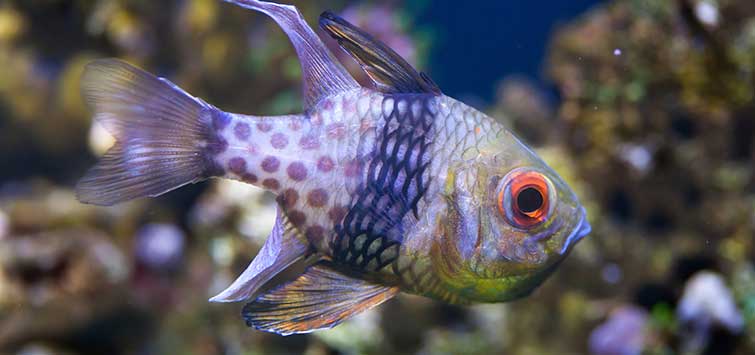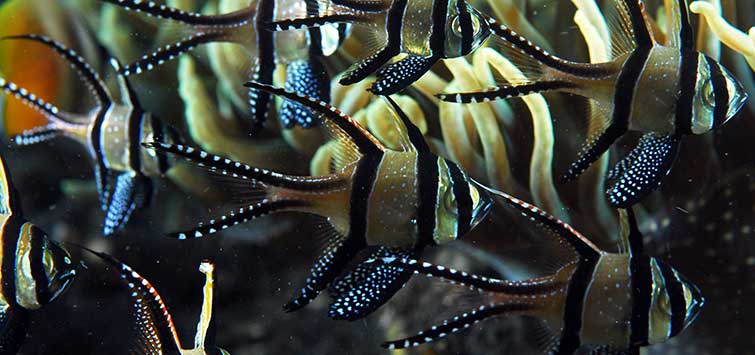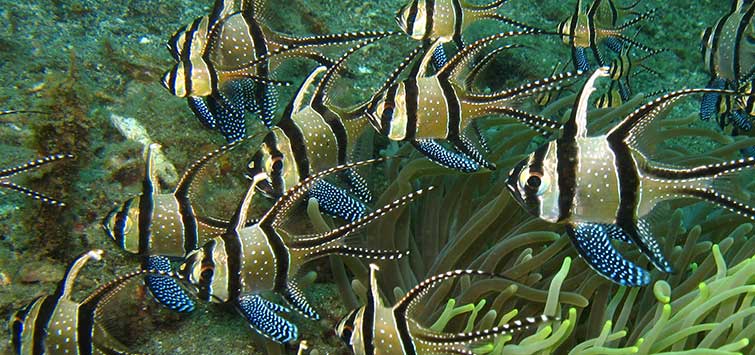Breeding the Pajama Cardinalfish
Author: David Watson
Another aquarist joins the ranks of hobbyist breeders of marine fish after an unexpected spawning motivates him to find out how to raise the fry.
My History of Breeding Fish
I have always had a passion for breeding fish. During my teen years I experimented with breeding a wide variety of freshwater fish, but although I succeeded with a few species, I failed with many. Being young and having little patience, my disappointments often led to abandoning the latest endeavor in hopes of success with a new species. My lack of persistence accounted for the plethora of fish varieties inhabiting my tanks and the conspicuous absence of the young fish I had envisioned.
Like many hobbyists I abandoned fishkeeping through my college years and early professional life, but my interest renewed after a visit to the Shedd Aquarium in Chicago. With my two young boys in tow, I began visiting local aquarium shops and in short order established a small fishroom in our basement.
Freshwater fish, specifically planted aquariums and breeding discus, were our main focus, but the reef aquarium setups at the store had caught my eye (and my sons’ eyes, too). The technology for marine aquarium keeping had obviously improved in the many years I had been away from the hobby and—with prompting from my sons, and countless hours of studying the subject—we set up our first reef aquarium.
An Interesting Discovery
A school of pajama cardinalfish Sphaeramia nematoptera, our first inhabitants, thrived in the reef tank environment. Several months into the setup my youngest son made an interesting discovery—there was something that seemed wrong with one of our cardinalfish. It appeared to have a mass of something in its mouth.
We watched for hours and it appeared the fish was actually carrying what looked like eggs. I soon discovered that cardinalfish were mouthbrooders; the fish in question was a male, and the mass in his mouth was in fact eggs. I had never expected the cardinalfish to spawn in our aquarium—after all, propagating saltwater fish was nearly impossible from what I had been told—yet here we were on the brink of having pajama cardinalfish babies.
Research and Trials
Well, as during my teen years, I envisioned having a tank full of baby cardinalfish, but this time my persistence didn’t let up. I began to study the subject online, found a few scientific papers that used larval pajama cardinalfish for their experiments, and asked questions at our local aquarium shop, but at the time could find little on the specifics of rearing techniques.
After four years of trial and error, and with the help of my sons, I finally figured out the necessary steps and now have baby pajama cardinalfish (albeit not as many as we would like) to trade in for store credit at our local aquarium shop.
I’m a big fan of conservancy and with all the concern about the status of the oceans’ reefs due to global warming, sharing our success will hopefully inspire other hobbyists to try their hand. The ability to produce captive-bred fish of any species is without a doubt advantageous for the hobby. Captive-bred fish avoid the stress associated with capture and shipping. The chance of their acquiring a disease is diminished as a result, which improves the survival rate for the fish and happiness of their owners.
Spawning
We’ve never actually witnessed a spawning event. It always occurs during the evening hours, but it’s quite obvious the next day when the lights come on. If there was any doubt who the male is in the partnership, you’ll know at this point. The male carries the eggs during the incubation period, constantly adjusting the position of the egg mass in his mouth.
On occasion some of the eggs slip out of his mouth only to be expertly gathered back. The larvae start hatching between day seven and eight and swim out of the male’s mouth soon after hatching. On day nine what is left of the egg mass disappears from the male’s mouth (probably discharged and consumed by other fish in the tank, but we’ve never seen this part of the spawning process either).
The first couple of attempts at spawning often lead to the male either eating the eggs or releasing them after a couple of days, but he quickly gets the hang of being a parent and soon settles down to incubating the egg mass. Once the spawning season has started, the pair will spawn every two to three weeks.
We usually collect the egg mass and hatching larvae from the male on day eight. This is the tricky part of the operation. We keep our pair in a 75-gallon reef aquarium, which gives the male plenty of hiding spots, but we eventually catch him with a little patience. This was more of a problem when the pair first started spawning, but it is now much easier because the male seems resigned to being caught.
Hatching the Eggs
Once the male is in the net he quickly discharges the egg mass and hatching larvae, and we release him back into the aquarium. We move the eggs into a plastic container and then transfer them into the egg incubator. We are careful not to expose the egg mass to air during the transfer.
Tank Parameters
The tank for hatching the eggs and raising the larvae must be set up as soon as you notice the male carrying eggs. This gives you ample opportunity to get the kinks out of the system, making sure the water parameters in the hatching and rearing tank are the same as the tank where the parents are housed.
We use a simple 5-gallon aquarium (sides covered with black cardboard), heater, aged sponge filter, and the most important element, a siphon system to exchange water with our reef aquarium. The reef aquarium essentially acts like a giant filter and helps to keep the water in our 5-gallon aquarium pristine. The siphon system allows us to adjust the flow rate into the 5-gallon aquarium, which is set for a slow drip through the first five to seven days, gradually increasing the flow rate as the larvae grow. A retrofitted 5-gallon bucket is the collection reservoir for our mini-hatchery, and a small pump carries the water back into the reef aquarium.
The egg incubator is constructed with 1½-inch PVC piping, 800-micron mesh netting (filter bag material), and a fine bubble airstone. The hatchery is placed into the tank allowing about ½ inch of clearance at the top of the water. This allows the hatching larvae to exit into the aquarium. The egg mass is placed into the hatchery and the airstone set to a fine stream, causing the eggs to tumble gently. Be careful not to have too forceful of an airstream or the egg mass will bubble out the top.
You should notice larvae hatching anywhere from a few minutes to a few hours after collecting the eggs. After 24 hours, all the eggs that are going to hatch should have done so, and you can remove the incubator.
Raising the Fry
Diet
Pajama cardinalfish have a pelagic larval phase in their development requiring a special feeding regimen. During the first two weeks after hatching, the larvae need a steady supply of the right-sized prey organism. We use saltwater rotifers. Rotifers are easy to culture at home and once enriched, provide the right-sized starter diet for the newly hatched larvae.
Another nutrient item needed during this crucial time is microalgae. Rotifers feed on the unicellular algae and in the process become enriched with the fatty acids and lipids crucial to the survival of the newly hatched larvae.
We use Nannochloropsis as our microalgae. Initially we tried culturing Nannochloropsis but found our results to be to inconsistent, so we switched to Nannochloropsis paste. Nannochloropsis paste gives consistency to our rotifer cultures, which is an important element to our success.
Rotifers
Once the eggs are moved into the incubator, it is time to add the rotifers and the Nannochloropsis paste. The rotifers need to be stocked heavily in the aquarium. I can’t overstate this importance. The newly hatched larvae have a very small yolk sac and must be able to find prey immediately.
How they make it into the plankton-rich waters of the ocean during their pelagic stage is a puzzle to me, as it seems they have such little time between hatching and finding food. So, stock heavily with rotifers and darken the water with Nannochloropsis paste (approximately 1 cc per 5 gallons twice a day) until you can’t see the bottom of the aquarium.
Starting on day 5, we enrich the rotifers with a highly unsaturated fatty acids (HUFA) supplement, and after 12 days we introduce HUFA-enriched brine shrimp. We overlap the feeding of rotifers with brine shrimp for about five to seven days, giving the larvae time to adjust to their new food.
Dry Larval Diet
Starting during the third week, we begin to add a small pinch of 50- to 100-micron dry larval diet once a day. The dry larval diet is fed with the enriched brine shrimp through the end of metamorphosis, which should be completed between 30 and 36 days post hatching.
Switching Tanks
After the young cardinalfish are observed consuming the dry larval diet, we stop feeding the enriched brine shrimp. The young cardinalfish are moved into a grow-out tank with live rock around seven to eight weeks post hatching and continue being fed the dry larval diet and a small daily portion of chopped mysis shrimp. After five to six months it’s time to share your young pajama cardinalfish with your aquarium friends or trade them in for store credit at your local aquarium shop.
Tips
• Cardinalfish larvae are very sensitive to rising ammonia levels. Using an ammonia badge is helpful in warning of an impending ammonia spike and potential disaster. Using a properly aged sponge filter and increasing the flow rate from the filter aquarium helps alleviate this concern.
• Start the rotifer culture at least three to four weeks prior to collecting the egg mass. This ensures an adequate amount of time to get your cultures producing the quantity of prey organism you will need.
• Keeping the larval rearing tank clean is crucial. Siphon the debris from the bottom daily and clean sponge filters as needed.
• Feeding the parents a high-quality diet (we use occasional feedings of live adult brine shrimp, frozen mysis shrimp, squid, and clam) will improve their fertility and increase the number of viable hatching larvae.
• Keeping a small lamp on 24 hours a day will enable the larvae and young cardinalfish to locate and hunt down their prey around the clock.
Acknowledgment
Anyone wanting to breed marine species will benefit, as we did, from reading Matt Wittenrich’s Complete Illustrated Breeder’s Guide to Marine Aquarium Fishes (TFH/Microcosm Professional Series, 2007).
See the full article on TFH Digital http://www.tfhdigital.com/tfh/201005/#pg83

.png?h=595&iar=0&w=2781&hash=5FD5E69473BCC22199FBFA2FB71B6033)



